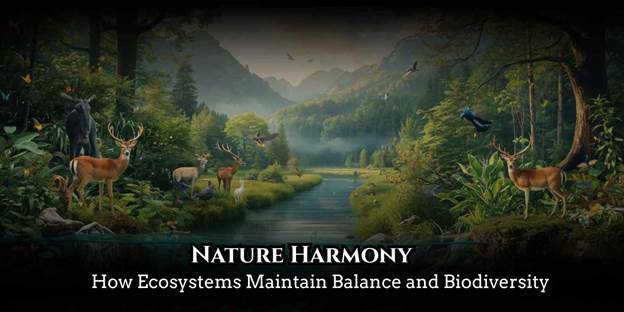From the tiniest microbes to the largest forests, the Earth thrives on nature harmony, a delicate balance that sustains all living organisms. This invisible web of life ensures that every creature, plant, and element plays a vital role in maintaining the planet’s health. Understanding the science of nature harmony reveals how ecosystems stay balanced, regenerate, and support biodiversity despite constant environmental pressures.
This article explores what nature harmony means, its importance, benefits, challenges, and real-world examples of how life on Earth continues to coexist in balance.

1. Understanding Nature Harmony: The Foundation of Life
At its core, nature harmony refers to the balanced interaction among organisms and their environment that supports sustainable ecosystems. Every component from soil microbes to apex predators contributes to ecological equilibrium.
This balance isn’t static; it’s dynamic and self-regulating. For example, when herbivores increase in number, predators also rise, naturally restoring balance. Similarly, plants absorb carbon dioxide and release oxygen, keeping the atmosphere stable.
2. The Evolutionary Science Behind Nature Harmony
The idea of nature harmony has deep roots in both science and philosophy. Ancient civilizations, such as the Greeks and Indigenous cultures, believed that humans must live in sync with nature’s rhythms. In modern ecology, scientists like Charles Darwin and Ernst Haeckel introduced the concepts of adaptation and ecosystem interdependence, highlighting how species evolve together to sustain environmental balance.
Over time, ecosystems have learned to self-correct. When a forest experiences wildfire, new growth eventually restores equilibrium. Coral reefs, despite bleaching, can recover under the right conditions. This cyclical resilience showcases how nature harmony has guided Earth’s survival for billions of years.
3. Why Nature Harmony Matters in Today’s World
In today’s industrialized age, nature harmony is more critical than ever. Human activities deforestation, pollution, and overfishing are disrupting natural cycles and threatening biodiversity. Maintaining harmony ensures that ecosystems continue providing essential services such as:
• Clean air and water through natural filtration systems
• Climate regulation by forests and oceans absorbing carbon
• Pollination that supports global food production
• Biodiversity protection, sustaining genetic variety essential for survival
When nature harmony weakens, these systems collapse, leading to global consequences such as climate change, habitat loss, and species extinction.
Regarding Article: Embracing Nature Harmony for a Balanced and Sustainable World
4. The Benefits of Living in Nature Harmony
Embracing nature harmony delivers both ecological and human benefits. Some of the most impactful include:
• Increased biodiversity that supports ecosystem resilience
• Improved soil fertility through balanced nutrient cycles
• Enhanced climate stability via carbon sequestration
• Sustainable livelihoods through eco-tourism and organic farming
Humans, as part of this ecosystem, thrive when nature harmony is preserved. Urban green spaces, for example, not only reduce pollution but also improve mental health and community well-being.
5. The Challenges Threatening Nature Harmony
Despite its resilience, nature harmony faces unprecedented challenges due to human interference. Key threats include:
• Climate change altering habitats and species migration
• Deforestation destroying ecosystems and reducing biodiversity
• Pollution contaminating air, soil, and oceans
• Overexploitation of natural resources disrupting food chains
When these pressures become overwhelming, ecosystems struggle to maintain ecological balance, causing cascading effects. Coral reef decline, desertification, and melting polar regions are clear warnings of a broken nature harmony.

6. Real-World Examples of Nature Harmony in Action
There are inspiring examples of nature harmony being restored across the globe:
• Yellowstone National Park, USA: The reintroduction of wolves rebalanced prey populations, vegetation growth, and river health.
• Mangrove Forests, Southeast Asia: These coastal ecosystems protect shorelines, support marine life, and absorb carbon an epitome of environmental balance.
• African Savannas: The intricate relationship between predators, herbivores, and grasslands demonstrates how life coexists in perfect rhythm.
These examples prove that when ecosystems are respected, nature harmony naturally rebuilds itself.
7. How Humans Can Restore and Protect Nature Harmony
Preserving nature harmony requires both global and local efforts. Some effective strategies include:
- Conservation and reforestation programs to restore degraded lands
- Sustainable farming to reduce soil depletion and chemical runoff
- Renewable energy adoption to combat climate change
- Wildlife protection laws ensuring species survival
- Environmental education promoting awareness of ecosystem balance
By adopting these actions, humanity can align with nature’s rhythm instead of working against it. Supporting green initiatives and reducing waste can make a real difference.
8. The Future of Nature Harmony: A Vision for a Sustainable Planet
The future of nature harmony depends on collective responsibility. Technology, science, and traditional wisdom can work together to rebuild lost balance. Artificial intelligence can monitor ecological systems, while indigenous conservation methods teach coexistence.
When innovation meets respect for natural laws, the Earth can restore its lost equilibrium and continue nurturing life in abundance.
Conclusion
In a world facing climate uncertainty, embracing nature harmony is not a choice it’s a necessity. From maintaining biodiversity to stabilizing climates, this balance is the blueprint for life’s sustainability. When humans respect natural systems and act as responsible stewards, ecosystems can thrive once more. To safeguard our planet’s future, we must learn, adapt, and live in alignment with nature harmony our most powerful ally for survival. Explore and support the movement toward restoring ecological balance today.
Pingback: Embracing Nature Harmony for a Balanced and Sustainable World - Regarding Planet